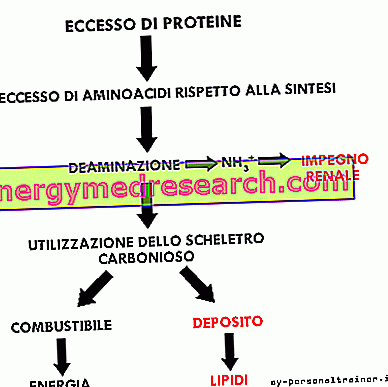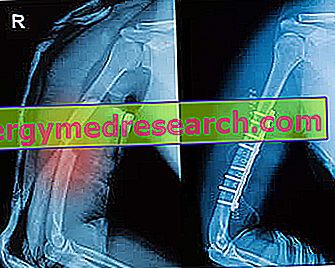
In this scheme the consequences of an excessive intake of proteins in the diet are reported.
Proteins are subject to a continuous process of demolition and synthesis, the protein turnover, through which the organism is able to continuously renew worn-out proteins replacing them with new protein material. Moreover, this process allows the body to replace the amino acids used for energy purposes and to deposit new ones to reinforce certain tissues (for example following physical exercise).
This quota varies from individual to individual and the daily protein intake must be adjusted accordingly. In any case, there is a limit threshold beyond which the ingested proteins cannot be used to increase protein synthesis.
At this point the fate of our proteins follows the pattern shown in the figure: they can be used to produce energy in the immediate (in case the total daily caloric intake is lower than the requirement) or can be converted into adipose tissue (in the case the total daily caloric intake is lower than the requirement).
Excess protein increases urinary calcium loss (causing hypercalciuria), this effect could be particularly deleterious for women and for those at risk of osteoporosis. It should be pointed out, however, that the increased absorption of the mineral in the intestine and the stimulation of the synthesis of anabolic hormones tend to compensate for the increased urinary calcium losses, eliminating the risk of osteoporosis or even reducing it.
In any case, both processes lead to an increased renal effort necessary for the elimination of nitrogen which represents the toxic part of the amino acids.
Protein breakdown requires lots of fluids (almost twice as much as the breakdown of carbohydrates and fats) this is particularly critical in hot climates and can lead to dehydration.Since the protein surplus elimination systems are normally efficient, a consumption not exceeding the recommendations is not to be considered at risk.
It is a good rule not to exceed twice the recommended protein intake level.
SOME CONSIDERATIONS.
In light of the above, the danger and above all the partial uselessness of some types of diets that foresee an excessive consumption of proteins (metabolic, ketogenic, hyperproteic in general) is evident.
However I remember that:
Carbohydrates, lipids and proteins also differ in their specific dynamic action (TID). This parameter represents the energy expenditure that occurs following the ingestion of these macronutrients. For proteins the TID value is very high and ranges from 15 to 35%; this means that 15-35% of the calories contributed by the proteins is spent on their digestion and absorption.
Example: assuming a protein intake of 100 calories 15-35 Kcal are spent to metabolize them so the actual caloric intake is reduced to 65-85 Kcal
A protein meal is able to stimulate the release of anabolic hormones such as testosterone and GH.
A diet rich in proteins maintains insulin levels constant, increases the basal metabolism, and stimulates lipolysis. The sense of hunger is inhibited thanks to the duodenal release of a substance called cholecystokinin which regulates the sense of satiety.
In particular conditions such as growth, pregnancy, convalescence or muscle strengthening, protein synthesis increases and therefore greater protein intake is necessary.
For a bodybuilder who trains seriously, the daily protein intake should remain within the range of 1.8 to 2.2 g of protein per kg of body weight.
Any further increase has minimal anabolic effects and rather serious side effects, as is the case with excessive use of anabolic steroids.
second part "



